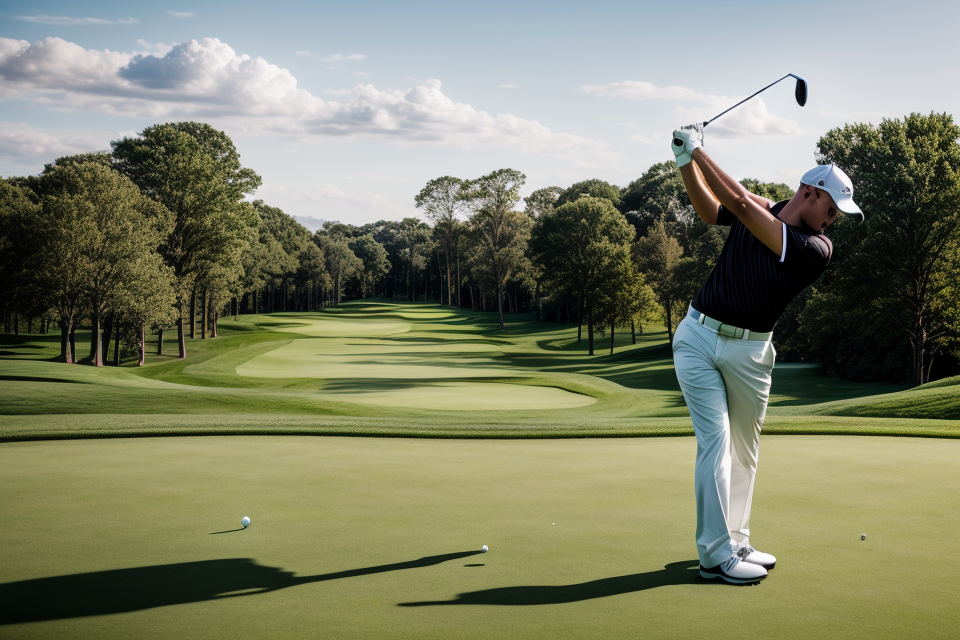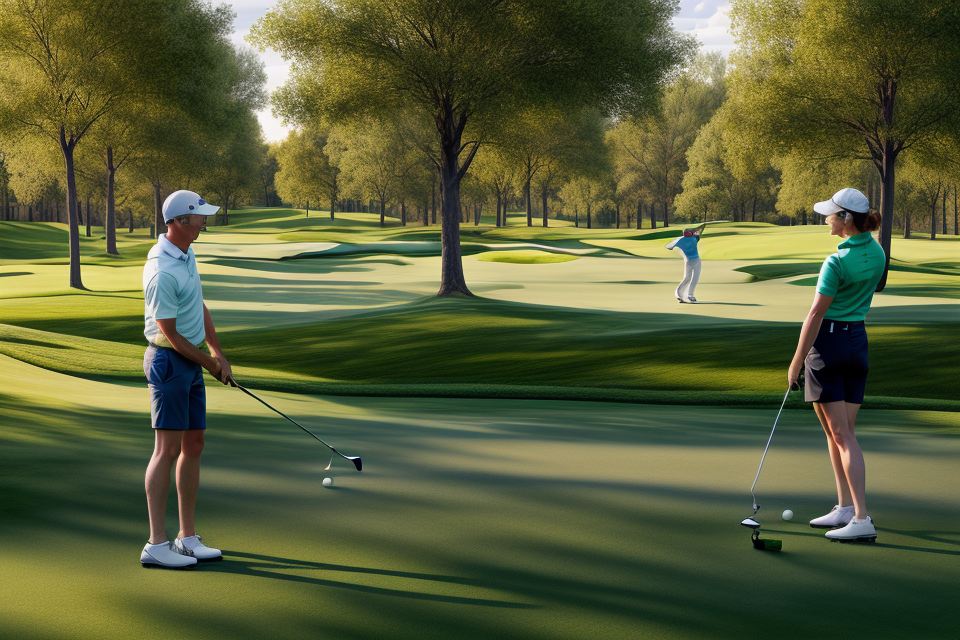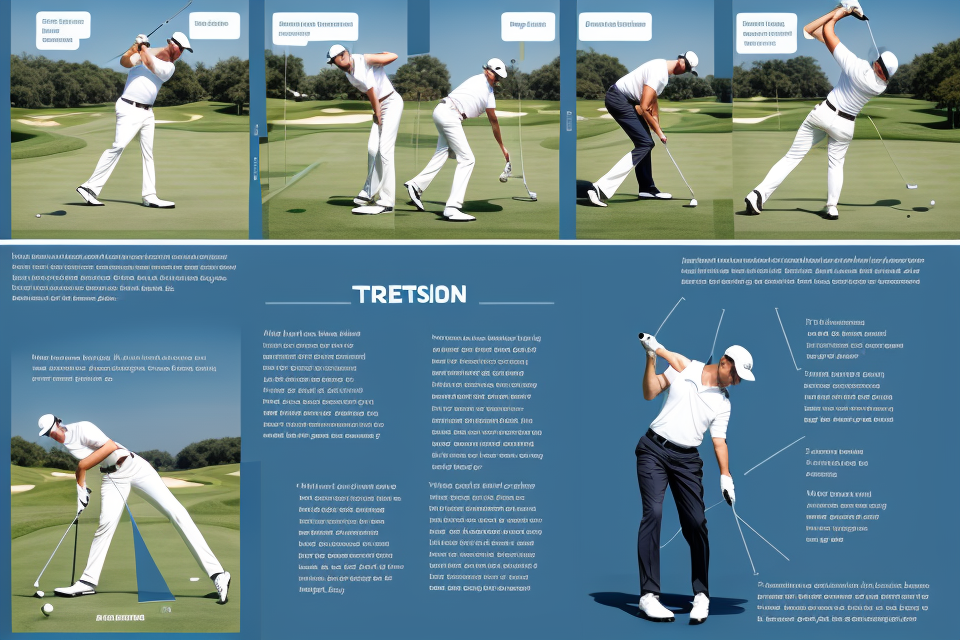
Golf is a sport that requires precision, patience, and practice. For beginners, hitting the ball straight and far can be a daunting task. However, with the right guidance and techniques, anyone can improve their golf swing. In this article, we will discuss some tips and tricks to help beginners improve their golf swing. From grip to follow-through, we will cover everything you need to know to hit the ball with confidence. So, grab your golf clubs and let’s get started!
Improving your golf swing as a beginner requires consistent practice and attention to proper technique. Focus on grip, stance, and alignment, and take lessons from a qualified instructor to learn the correct swing mechanics. Practice swinging in slow motion to develop muscle memory, and gradually increase your swing speed as you become more comfortable. Additionally, pay attention to your body positioning and posture throughout the swing, and be sure to follow through to the finish. Regularly practicing these fundamentals will help you improve your golf swing and ultimately lower your scores.
Understanding the Golf Swing
The Importance of Posture
Maintaining proper posture throughout the golf swing is crucial for several reasons. Firstly, it allows for the proper alignment of the body, which is essential for achieving a straight and powerful swing. Additionally, maintaining the correct posture helps to prevent excessive strain on the back, neck, and other muscles, which can lead to injury over time.
The correct posture for a golf swing involves standing with your feet shoulder-width apart, with your knees slightly bent. Your weight should be evenly distributed on both feet, with your weight shifted slightly onto your front foot as you prepare to swing. Your torso should be tilted slightly forward, with your shoulders level and your arms hanging loosely by your sides. Your head should be up, with your eyes focused on the ball.
To maintain proper posture throughout the swing, it is important to keep your shoulders level and your weight shifted onto your back foot as you make contact with the ball. As you finish your swing, your weight should be evenly distributed on both feet, with your torso upright and your head facing forward.
In addition to maintaining proper posture during the swing, it is also important to practice good posture when not swinging the club. This means standing up straight with your shoulders back and your head up, even when waiting for your turn to hit. Overall, proper posture is essential for a powerful and injury-free golf swing, and should be practiced both on and off the course.
The Golf Swing Motion
Sequence of Movements in a Golf Swing
The golf swing motion is a complex sequence of movements that involves various muscles in the body. It starts with the address position, where the golfer stands with the golf club resting on the ground behind them. The golfer then takes a few practice swings to get a feel for the club and the ball. As the golfer starts the swing, they rotate their hips and upper body away from the ball, while keeping their lower body facing the target. The golfer then transfers their weight onto their back foot and starts to bring the club back down towards the ball. As the club reaches the top of the backswing, the golfer rotates their hips and upper body back towards the ball, while also shifting their weight back onto their front foot. Finally, the golfer uncoils their body and brings the club down towards the ball, hitting it with the clubface square to the target.
Importance of the Power Move
The power move is a crucial part of the golf swing motion. It refers to the explosive rotation of the hips and upper body that generates power and speed in the swing. The power move occurs as the golfer starts to bring the club back down towards the ball, just after the top of the backswing. At this point, the golfer should shift their weight back onto their front foot and rotate their hips and upper body towards the target. This rotation creates a leveraged action that allows the golfer to generate maximum power and speed in the swing. It is important to note that the power move should be smooth and controlled, without any jerky or erratic movements. A good way to practice the power move is to take a few practice swings and focus on rotating the hips and upper body explosively, while keeping the lower body in place.
Warming Up and Stretching
As a beginner golfer, it’s important to understand the importance of warming up before a round of golf. Warming up helps to prepare your body for the physical demands of the game and can help prevent injury.
Stretching is an important part of the warming up process. Stretching can help to improve flexibility and range of motion, which can help you to make a better golf swing.
Here are some stretches that you can do to warm up before a round of golf:
- Back stretches: Swinging your arms in large circles and rolling your shoulders can help to loosen up your back muscles.
- Shoulder stretches: Rotating your shoulders in circles and raising your arms overhead can help to improve shoulder mobility.
- Leg stretches: Standing with your feet hip-width apart and leaning forward at the hips can help to stretch your legs.
It’s important to take the time to properly warm up and stretch before a round of golf. This will help to prepare your body for the physical demands of the game and can help prevent injury.
Selecting the Right Equipment
Choosing the Right Clubs
When it comes to improving your golf swing as a beginner, choosing the right clubs is crucial. It’s important to understand the different types of clubs available and how to choose the right ones for your swing. Here are some tips to help you make the right choice:
Understanding the Different Types of Clubs
There are several types of golf clubs, each designed for a specific purpose. The most common types of clubs include:
- Drivers: These clubs are used for long drives and are the most powerful clubs in a golfer’s bag.
- Fairway woods: These clubs are used for shots off the fairway and are less powerful than drivers.
- Hybrids: These clubs are a combination of irons and woods and are designed for a variety of shots.
- Irons: These clubs are used for a variety of shots, including approach shots and chip shots.
- Wedges: These clubs are used for high-lofted shots, such as sand shots and lob shots.
- Putters: These clubs are used for putting on the green.
How to Choose the Right Clubs for Your Swing
Choosing the right clubs for your swing depends on several factors, including your skill level, physical ability, and playing style. Here are some tips to help you choose the right clubs:
- Consider your skill level: As a beginner, it’s important to choose clubs that are easy to use and will help you improve your swing. If you’re a high handicapper, you may want to consider using a driver with a lower loft angle, as this will help you get the ball airborne more easily.
- Fit your clubs to your physical ability: Your physical ability is another important factor to consider when choosing clubs. If you have a slower swing speed, you may want to consider using heavier clubs with more loft, as this will help you get the ball airborne more easily.
- Choose clubs that fit your playing style: Your playing style is also an important factor to consider when choosing clubs. If you prefer a more aggressive playing style, you may want to consider using a driver with a higher loft angle, as this will help you hit the ball further.
By understanding the different types of clubs and how to choose the right ones for your swing, you can improve your golf game and enjoy the sport more.
Proper Grip and Stance
The proper grip and stance are essential components of a successful golf swing. These elements may seem minor, but they have a significant impact on the overall outcome of the shot. Here are some key points to consider when it comes to grip and stance:
- Grip
- The golf grip is typically a neutral grip, which means that the hands are placed in a way that allows for a natural and relaxed hold on the club.
- The dominant hand should be placed on the grip of the club, with the index finger wrapping around the handle.
- The non-dominant hand should be placed on the grip, with the thumb resting on the bottom hand’s index finger.
- The grip should be relaxed, with the hands positioned in a way that allows for a natural and comfortable swing.
- Stance
- The stance is crucial for a successful golf swing, as it helps to maintain balance and control throughout the shot.
- The feet should be shoulder-width apart, with the toes pointing slightly outwards.
- The knees should be slightly bent, with the weight distributed evenly on both feet.
- The hips should be positioned slightly towards the target, allowing for a smooth and natural swing.
- The torso should be tilted slightly forward, with the arms and club held out in front of the body.
By paying close attention to these details, beginners can improve their grip and stance, setting themselves up for a more successful and enjoyable golf experience.
Improving Your Technique
Developing a Smooth Swing
As a beginner golfer, it’s important to develop a smooth swing to ensure consistent ball contact and prevent injury. Here are some tips to help you develop a smooth swing:
- Warm-up properly: Before starting your golf session, warm up your muscles by stretching or hitting a few practice balls. This will help you avoid injury and increase your swing speed and accuracy.
- Keep your body relaxed: A tense body can lead to an uneven swing, so it’s important to keep your muscles relaxed throughout the swing. Take deep breaths and focus on maintaining a smooth rhythm.
- Maintain a good posture: Keep your spine straight and your shoulders relaxed throughout the swing. Avoid hunching over or leaning away from the ball, as this can throw off your balance and cause a swing that’s too slow or too fast.
- Use your legs: A strong lower body is essential for a smooth swing. Engage your core and use your legs to generate power and stability.
- Keep your head still: Avoid moving your head during the swing, as this can throw off your balance and affect your aim. Instead, focus on keeping your head still and your eyes on the ball.
- Practice your swing: To develop a smooth swing, it’s important to practice regularly. Take lessons from a golf pro or use a golf simulator to get feedback on your technique. With time and practice, you’ll develop a smooth swing that will help you improve your game.
Increasing Power and Accuracy
Improving your power and accuracy in golf swing is a gradual process that requires patience, practice, and understanding of the mechanics of the swing. Here are some techniques that can help you increase your power and accuracy:
Proper Setup
The first step in increasing power and accuracy is to have a proper setup. Ensure that your feet are shoulder-width apart, with the ball positioned in the center of your stance. Your knees should be slightly bent, and your hands should be ahead of the ball. Your shoulders should be aligned with your hips, and your weight should be evenly distributed on both feet.
Warm-Up
Before starting your swing, it’s essential to warm up your muscles to prevent injury and improve your performance. Warm-up exercises such as stretching, light swinging, and putting can help you loosen up and prepare for the swing.
The Power Move
The power move is a crucial aspect of increasing power and accuracy in your golf swing. It involves rotating your hips and turning your torso away from the target, creating a powerful downward movement of the club. This movement should be done in sync with your arms and hands, which should also be turning over at the right time.
Keeping Your Head Still
Keeping your head still during the swing is crucial for accuracy. A moving head can cause a swing that is off-target, leading to a misaligned shot. Keep your head still and focused on the target throughout the swing, and avoid any unnecessary movements.
Maintaining Your Posture
Maintaining your posture throughout the swing is also important for accuracy. A slouched or hunched posture can cause an unbalanced swing, leading to an off-target shot. Keep your shoulders square to the target, and avoid leaning forward or backward.
Using Your Legs
Using your legs effectively can also help you increase power and accuracy. As you swing, push off with your legs, transferring your weight to your front foot, and unleashing your power move. This will help you maintain balance and control throughout the swing.
By implementing these techniques, you can improve your power and accuracy in your golf swing. Remember that practice is key, and it’s essential to focus on the mechanics of your swing to make gradual improvements over time.
Fixing Common Mistakes
As a beginner golfer, it’s important to understand and fix common mistakes that can negatively impact your swing. Here are some of the most common mistakes made by beginner golfers and tips on how to fix them:
- Slicing the Ball: A slice occurs when the ball curves to the right for right-handed golfers and to the left for left-handed golfers. To fix this mistake, try the following:
- Check your grip: Make sure your hands are placed properly on the club. A weak grip can cause a slice, while a strong grip can cause a hook.
- Address your ball position: Make sure your ball is placed in the center of your stance for a neutral ball flight.
- Swing on a proper plane: Swing the club on a neutral plane, neither too inside nor too outside.
- Hooking the Ball: A hook occurs when the ball curves to the left for right-handed golfers and to the right for left-handed golfers. To fix this mistake, try the following:
- Check your grip: Make sure your hands are placed properly on the club. A weak grip can cause a hook, while a strong grip can cause a slice.
- Casting the Club: Casting occurs when the club moves too much from the inside to the outside during the swing. To fix this mistake, try the following:
- Use a proper grip: Make sure your hands are placed properly on the club.
- Keep your wrists firm: Use a firm wrist action during the swing to prevent casting.
- Use a full swing: Make sure you’re using a full swing, not just a chipping motion.
- Losing Your Tempo: Losing your tempo can cause a variety of swing mistakes. To fix this mistake, try the following:
- Use a steady, consistent rhythm: Swing the club at a steady, consistent pace.
- Avoid rushing or slowing down: Try to avoid rushing or slowing down your swing.
- Use a proper weight shift: Make sure you’re shifting your weight properly during the swing.
By identifying and fixing these common mistakes, you can improve your golf swing and become a better golfer. Remember to practice regularly and seek out professional instruction if needed.
Practice Drills
When it comes to improving your golf swing as a beginner, practice is key. However, it’s important to have a structured approach to your practice sessions to ensure that you’re effectively improving your technique. One way to do this is by incorporating practice drills into your routine.
Incorporating practice drills into your routine can help you to focus on specific aspects of your swing, such as your grip, stance, or shoulder turn. These drills can also help to ingrain proper muscle memory, which will ultimately lead to a more consistent and effective swing.
When incorporating practice drills into your routine, it’s important to keep a few things in mind. First, make sure that you’re using proper technique when performing the drills. This means paying attention to your grip, stance, and shoulder turn, as well as other key aspects of your swing.
Second, be sure to practice the drills regularly. Consistency is key when it comes to improving your swing, and practicing the drills on a regular basis will help to ingrain the proper muscle memory.
Finally, be sure to vary your practice drills. While it’s important to focus on specific aspects of your swing, it’s also important to practice a variety of drills to ensure that you’re improving all aspects of your technique.
Some examples of practice drills that you can incorporate into your routine include:
- Grip drills: These drills can help to improve your grip on the club, which is essential for a proper swing. Examples include holding the club with your fingers rather than your palms, or using different grip pressure.
- Stance drills: These drills can help to improve your stance, which is important for balance and stability during your swing. Examples include standing with your feet close together or far apart, or standing with your feet in different positions.
- Shoulder turn drills: These drills can help to improve your shoulder turn, which is important for generating power in your swing. Examples include using a resistance band to resist your shoulder turn, or using a mirror to check your shoulder turn in your reflection.
Overall, incorporating practice drills into your routine can be a highly effective way to improve your golf swing as a beginner. By focusing on specific aspects of your technique, and practicing regularly and consistently, you can develop a more consistent and effective swing.
FAQs
1. What are the basic fundamentals of a good golf swing for beginners?
The basic fundamentals of a good golf swing for beginners include a proper grip, stance, and posture. A good grip should be firm but relaxed, with the hands placed appropriately on the golf club. The stance should be wide and comfortable, with the feet shoulder-width apart. Posture should be upright, with the shoulders square to the target and the head up.
2. How should I position my body during the swing?
During the swing, the body should be positioned in such a way that the spine remains straight and the weight is evenly distributed on both feet. The knees should be slightly bent, and the arms should be relaxed and swinging naturally. The body should pivot around the hips, allowing for a smooth and powerful swing.
3. What is the correct way to use my legs and core in the swing?
The legs and core are essential in providing power and stability in the swing. The legs should be used to generate force by pushing off from the ground, while the core should be engaged to maintain balance and control. The hips should also be rotated, allowing for a smooth transfer of power from the lower body to the upper body.
4. How should I practice my swing to improve it?
Practice is key to improving the golf swing. Beginners should start by practicing the basic fundamentals in front of a mirror or with the help of a golf pro. It’s important to focus on the correct body positioning, grip, and posture. Once these fundamentals are mastered, more advanced techniques such as ball positioning and swing speed can be practiced. Regular practice will help develop muscle memory and improve overall technique.
5. What are some common mistakes to avoid in a golf swing?
Common mistakes to avoid in a golf swing include a weak grip, a closed stance, and an unbalanced body position. A weak grip can lead to a loss of control, while a closed stance can cause a slice. An unbalanced body position can lead to a lack of power and accuracy. It’s important to focus on maintaining a strong grip, a wide stance, and a balanced body position throughout the swing.


